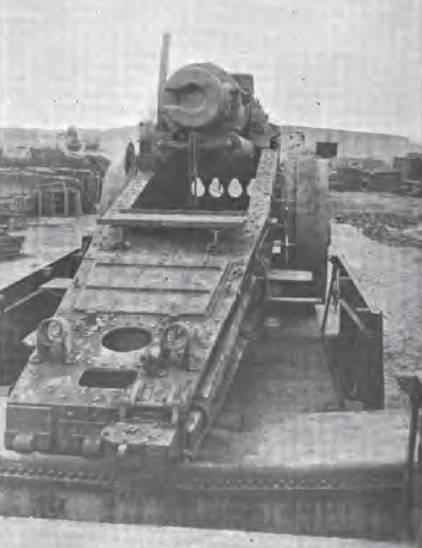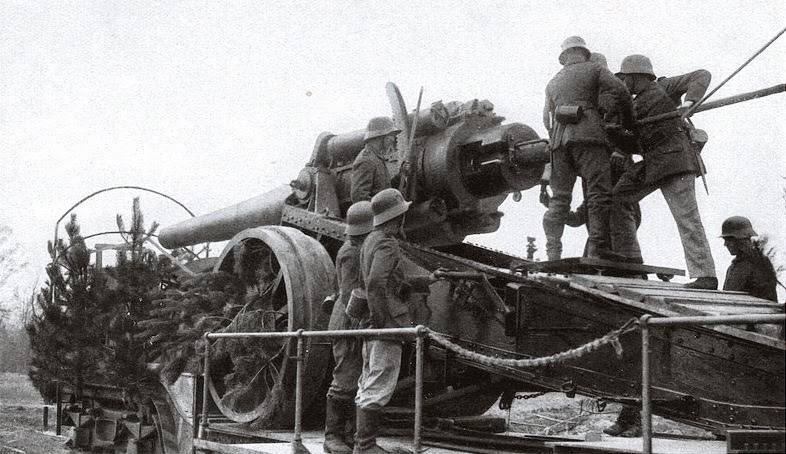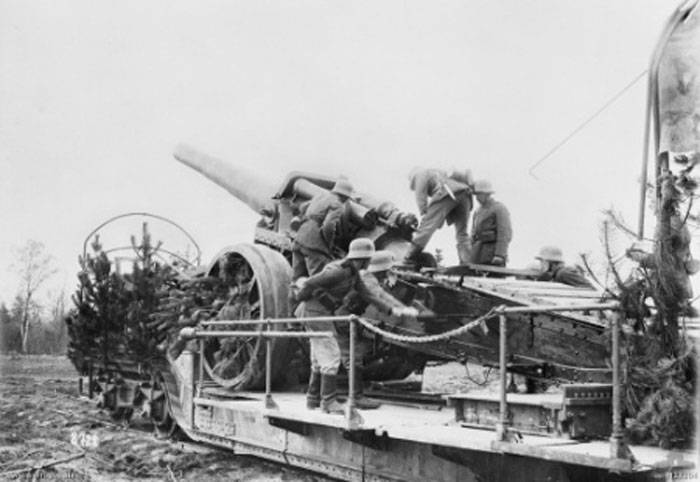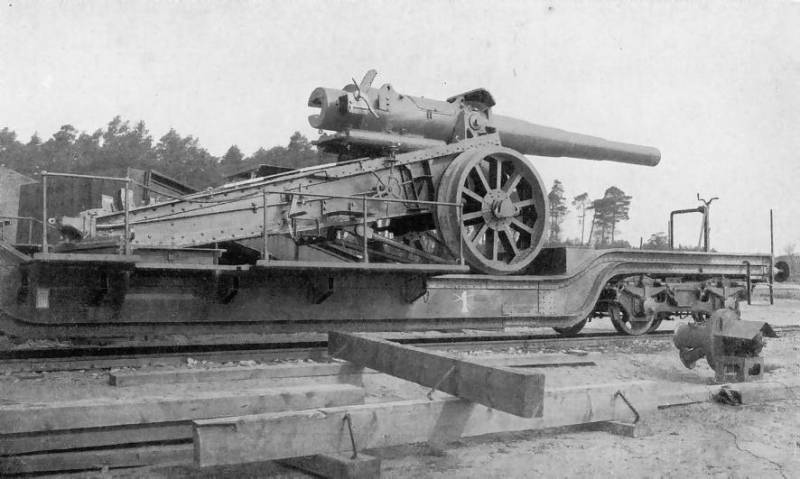Railway gun 17 cm SK L / 40 IRL auf Eisenbahnwagen Samuel (Germany)
The prerequisites for the emergence of large-capacity guns on railway transporters were simple and clear. The army needed more powerful weapons, for which it was proposed to use the guns of ships and coastal artillery. However, similar weapon differed from the "land" large dimensions and weight. As a result, he needed special gun carriages and tractors with the corresponding characteristics. As an alternative, special railway conveyors were proposed for gun carriages and tractors. The installation of the gun on the railway platform allowed solving all the main tasks at an affordable price.
The original ideas were implemented in the 15 cm SK Natan project, in which the 149,1-mm naval gun was installed on the platform. According to the results of the operation of such systems, the military wanted to get similar railway tools, which are characterized by increased performance and increased power. The 172,6-mm 17 cm SK L / 40 naval gun was chosen as the “main caliber” of one of the promising systems. The development of means for transferring ship guns to land was entrusted to the concern Krupp, who had extensive experience in creating artillery systems of various classes.
The appearance of a new railway complex was preceded by interesting events that had some influence on the appearance of the future system. The 17 cm SK L / 40 cannon was originally developed to arm warships of the Braunschweig type. Subsequently, the battleships of the project Deutschland became its carriers. In both cases, the 172-mm gun was a medium caliber, complementary to more powerful weapons. In 1916, several ships of the Braunschweig class were transferred to training ones, and therefore they lost part of their weapons. Released 17-see guns with the remaining resources were transferred to the German army for use as a field.
Before being transferred to the front line, the guns had to be supplemented with a new gun carriage, providing transportation by land. With the use of existing developments, as well as some new units, a two-wheeled carriage was created with a single bed and complete guidance devices. In this form, the gun, towed by technology with the appropriate characteristics, could move on existing roads and go to the specified position. The appearance of the wheel carriage was reflected in the name of the modernized gun, now it was called 17 cm SK L / 40 IRL (In Räder-Lafette).
For a significant increase in mobility, a gun with an overhead carriage should be mounted on a railway conveyor. Krupp designers have developed such a technique, and the tasks have been solved very simply. They did not make a completely new means of mounting the gun on the platform. Instead, it was proposed to install a cannon along with the existing carriage on the last one. In order to use the available capabilities more effectively, the platform had to be equipped with a number of uncomplicated devices for fastening and pointing the gun.
In accordance with a very complex notation, the promising railway gun was officially named 17 cm Schnellladekanone L / 40 IRL auf Eisenbahnwagen - “17-cm fast-reload gun with a barrel length 40 caliber on a wheel mount, on a railway platform.” Such a long and complicated name probably didn’t like even the developers themselves, which is why the project soon got its own name Samuel. It is hardly surprising that the gun became famous under the second name.
The mobility of the Samuel cannon was to be provided by a specially designed railway platform. To reduce the overall dimensions of the artillery complex and reduce the likelihood of capsizing during firing, it was decided to use a platform-conveyor with curved power elements. In fact, the platform was divided into three parts, and the average was significantly lower than the others. It was supposed to have a weapon, while the other two sections of the power kit had fastenings for mounting carts. Two standard carts with two wheel pairs on each were used. Unlike some other German artillery systems of the same appearance, the 17 cm SK L / 40 IRL auf Eisenbahnwagen was equipped with relatively simple means of holding in place when firing. Instead of jacks, anchors, etc. used standard shoes under the wheels.
In the central section of the platform, Krupp designers have placed a platform for the installation of a gun. In front of the platform, there was a swivel ring for mounting the wheels of the carriage. In addition, with the help of special brackets, it was connected to the corresponding fastenings of the gun frame. The presence of the ring made it possible to turn the gun and direct it within a small horizontal sector. At the rear of the implement platform there was a massive curved stop for the installation of a vomer. When changing the position of the gun carriage, the latter should slide along the stop. During the shooting, respectively, the frame and the vomer transmitted a recoil impulse to the support, and he redirected him to the power set of the platform.
Due to the large size of the carriage on the conveyor platform, additional side platforms were provided to facilitate the work with the tool. For the safety of the calculation platform equipped with a light fence. With the help of additional platforms, gunners could work normally with all devices of the gun during deployment at the firing position and during firing. In fact, it was the side platforms that allowed to place on the conveyor anything besides a large-sized mast.

The gun carriage and the emphasis used for horizontal guidance. Photo of Wikimedia Commons
The 17 cm SK L / 40 IRL cannon was to be used as part of the new complex, along with the standard carriage. The main element of the latter was a large bed assembled on rivets of several separate parts. In front of her, characterized by an increased cross-section, were mounting for the axis of the wheels and hinges for rocking artillery units. The tapering rear part had fastenings for transportation of various additional equipment, and also had a vomer to rest in the ground. The carriage was completed with two large-diameter spoke wheels.
With the help of trunnions in the front part of the carriage, the swinging part was fastened in the form of a bassinet, a barrel and an underride device. To suppress part of the recoil pulse and return the barrel to its original position, recoil devices with hydraulic and spring elements were used. The mechanisms of the swinging unit allowed vertical guidance within the sector from 0 ° to + 45 °. According to some data, the actual sector of guidance provided by the gun carriage was wider - up to + 47,5 °, but the aiming devices allowed firing only at + 45 °.
The 17 cm SK L / 40 IRL gun had a barrel with a 172,6 caliber mm long 6,9 m. A horizontal wedge slide was used. A characteristic feature of a rifled barrel was a large wall thickness, typical of the guns of the time. A relatively long barrel allowed to accelerate shells up to speed 785-815 m / s, depending on their type.
For use with the gun, two high-explosive shells with different characteristics were offered. The product L / 3 Kz had a total mass of 64 kg, of which 3,4 kg accounted for an explosive charge. Due to the initial speed of 785 m / s, such a projectile could fly at a distance of 16,9 km. An L / 4.7 Kz shell was also developed. He weighed 62,8 kg and carried a 6,5 kg charge. Due to more advanced aerodynamics, the less heavy projectile accelerated to 815 m / s and flew 24 km. The propellant charge was placed in a metal sleeve. At the same time, it was envisaged to enhance the charge due to an additional cap with gunpowder placed in the chamber in front of the sleeve. A similar method of loading has long been used. naval guns, however, was a novelty for land artillery.

Preparing for the shot. Photo Armamentosdaprimeiraguerramundial.blogspot.ru
Due to the large weight of the ammunition, the reloading of the gun was carried out by several people. Bring the shell and the sleeve to the breech should have been two loaders using special devices. A crane for feeding heavy elements of the shot was not provided. The rate of fire was 1 per minute.
Prospective railway gun was quite large and heavy. The total length of the platform and the gun was 16,75 m, combat weight - 61,5 t, without taking into account ammunition. The complex was to be transported at the expense of existing locomotives, both separately and as part of echelons. For obvious reasons, a locomotive, a conveyor with a tool and a wagon with ammunition should have been present in the minimum composition. After arriving at the firing position, the calculation could perform the necessary calculations and hover the gun. Due to the rotation of the mast around the vertical axis, the aiming on 13 ° was carried out to the right and left of the longitudinal axis. Elevation angles range from 0 ° to + 45 °. To perform a horizontal pickup at large angles, it was necessary to change the position of the entire complex, diverting it to the appropriate section of the tracks.
At the end of the 1916 of the year or at the beginning of the 1917, Krupp produced the first copies of the 172-mm cannon on the carriage and on the railway conveyor. In the first months of 1917, these weapons were handed over to the army. Soon the number of vehicles was brought to 30 units. For the exploitation of new weapons as part of the ground forces, 15 new batteries were formed, each of which was to receive two Samuel systems. According to some reports, in the future, the production of such products continued, and a total of about 70 guns were installed on railway platforms. It should be noted that the version of the construction of seven dozen guns on conveyors does not quite correspond to other known data. Apparently, in such a configuration, there were only three dozen guns. Information on a larger number of weapons may be due to incorrect interpretation of data on the distribution of guns, since a significant number of 17 cm SK L / 40 IRL guns were used with a towed wheeled carriage.
172-mm naval guns on railway transporters were rather actively used by German forces on the Western Front. They were attracted to various operations in order to enhance the firepower of the advancing units. For example, eight guns were involved in the 1918 Spring Offensive of the Year. Due to the large caliber of the gun, the enemy inflicted noticeable damage, complementing other field artillery well. High range characteristics were also useful in battle, including due to limited angles of horizontal guidance. Because of them, firing positions sometimes had to be equipped at a greater distance from the target, in the place where there were suitable paths, which, however, was compensated by the characteristics of the gun.

Samuel in position. Photo of Wikimedia Commons
Over time, some 17 cm SK L / 40 IRL auf Eisenbahnwagen guns were lost for one reason or another. Thus, in 1918, the Belgian forces managed to capture six guns. Two more such guns in the same year went to France. A number of guns were lost in battle, due to the development of a resource or due to accidents. By the beginning of the First Armistice of Compy, Germany had only 14 30 rail guns built. In connection with the signing of an agreement on the cessation of hostilities, the exploitation of such weapons has ceased.
Subsequently, the Versailles Peace Treaty was signed, which, among other things, stipulated permits and arms bans for Germany. In accordance with the agreement, German troops were no longer entitled to use large-caliber artillery systems. All remaining 17 cm SK L / 40 cannons IRL auf Eisenbahnwagen / Samuel in the country were subsequently written off and disposed of. The destruction process ended in 1922. The further fate of the guns captured by the opponents of Germany is unknown. Apparently, they also went to the smelter. Perhaps even before German.
In the project 17 cm SK L / 40 IRL auf Eisenbahnwagen was proposed a very interesting and not too complicated way of turning a naval gun into a railway tool. Using the existing carriage, the designers of the Krupp concern presented a very interesting example of an artillery system with high firepower and good mobility. Nevertheless, a series of three dozen guns could not have a noticeable impact on the course of the war. 172-mm shells inflicted serious damage to the enemy on various sectors of the front, but still could not save Germany from defeat.
On the materials of the sites:
http://alternathistory.com/
http://navweaps.com/
http://forum.axishistory.com/
http://armamentosdaprimeiraguerramundial.blogspot.ru/


Information